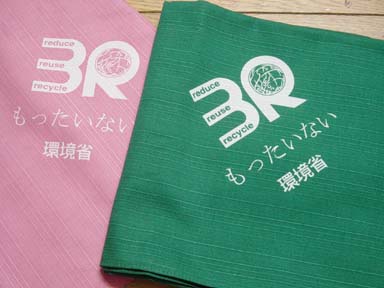風呂敷は、日本古来より幅広く使われてきた暮らしの布。運搬や収納をはじめ、贈り物を包んだり、敷物、掛け物として活用されてきました。風呂敷は、その歴史や伝統からも日本のくらしの文化の象徴とも言えます。
英語でいうならBath Matにあたる布が、風呂敷と呼ばれるようになったのは、江戸時代(1603-1868)中期以降のこと。当時、庶民の社交場として栄えた銭湯で、湯上がりに敷いていた布がいつしか着替えなどを運ぶ布となりました。その頃、庶民の生活が活発化し、商いや旅や物見遊山が盛んになり、物の運搬に風呂敷が普及していきます。
また風呂敷は、婚礼とも係わりが深く、江戸中期以降、昭和(1926-1989)の中頃まで、嫁入りの荷物を包んだり、嫁入り道具として、吉祥文様を染めた大中小の風呂敷が親によって用意されました。
江戸時代に普及した風呂敷は、人から人へと使い継がれ、知恵や創意工夫によっていろいろな形のものを包む布として活躍し、昭和後期1975年頃まで日本の暮らしになくてはならない存在でした。しかし、その後、風呂敷は衰退の道を辿ります。近年、環境保全や日本の文化を見直そうとする市民活動が起こり、伝統的な使い方だけではなく、新しい風呂敷の提案がなされ、袋物として、ギフトラッピングとして、インテリアや食卓の演出など、活用の幅はさらに広がりを見せています。
風呂敷の大きな特長は、再使用できることです。風呂敷には捨てるという動詞はありません。風呂敷を活用することは、包装材の減量や無駄な包装の抑制をもたらし、省資源、省エネルギーにも貢献します。また、風呂敷はその存在そのもので循環のかたちを見せてくれます。人の手で包み結び、目的に合わせて使った風呂敷は、解くとふたたび、もとの一枚の布に戻ります。
世界的な規模での地球環境保全への対策が急がれ、基本的なライフスタイルとして3R(発生抑制、再使用、再利用)が広く叫ばれる今、日本古来の風呂敷がふたたびはばたく時なのかもしれません。
|
A furoshiki is an oversized square cloth, dyed
in one of any number of colors and patterns, used for carrying
and storing things, as well as for wrapping gifts, spreading
on the floor, or even decorating a room.
The word furoshiki, literally meaning "bath
spread," dates from the mid-Edo Period (1603-1868). Furoshiki
were first used at public bathhouses - then a social center for
the common people - as a wrap to hold the bather's clothes. Gradually,
it came to be used as a wrap for carrying a change of clothes
and toiletries. The use of furoshiki as a way to carry things
spread quickly as commerce became more active and people moved
around more for both commerce and pleasure.
Furoshiki were used during weddings as well.
From the mid-Edo Period until the mid-Showa Period (1926-1989),
the parents of the bride would often prepare furoshiki with patterns
such as cranes, other symbolic birds, fans, pine trees and waves,
as they were all believed to usher in happiness and fortune.
After furoshiki gained greater popularity in
the Edo Period, people came up with various ways to wrap things
and handed the tradition down through generations until it became
an indispensable tool for the life of the Japanese. However,
the custom and culture of using furoshiki faded away in about
1975, the mid-Showa Period. It is just a very recent trend to
revive the use of furoshiki as movements to conserve the environment
and re-evaluation of Japanese traditional culture have become
more prominent. A number of new and innovative uses of furoshiki
have been proposed on top of its conventional techniques. The
furoshiki is becoming more and more versatile, being used, for
example, as a gift wrapper or as a table covering or other interior
decoration.
An important feature of furoshiki is that it
is always reused. One would never throw away a furoshiki. Using
furoshiki will thus reduce the use of raw materials to create
packaging and decrease the use of excessive packaging, and thus
contribute to saving resources and energy. The furoshiki itself
symbolizes a kind of circulation - people wrap things with a
furoshiki, tie the ends of the cloth and make a knot which differs
depending on the furoshiki's current role, but once the knot
is untied and the cloth is spread, the original form of the furoshiki
- a simple cloth - comes back.
A lifestyle based on the 3Rs (the reduction,
reuse and recycling of waste) plays an important role as one
of the measures to conserve the environment, and this lifestyle
is truly necessary today. It may be a time for the Japanese traditional
cloth, the furoshiki, to flourish again.
|

